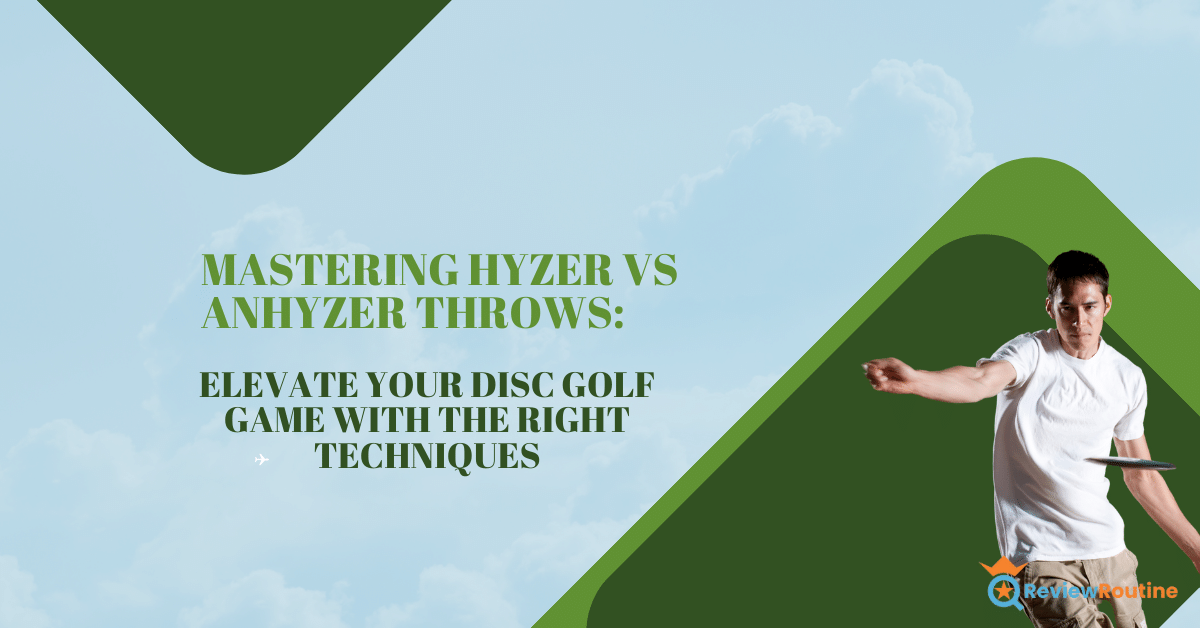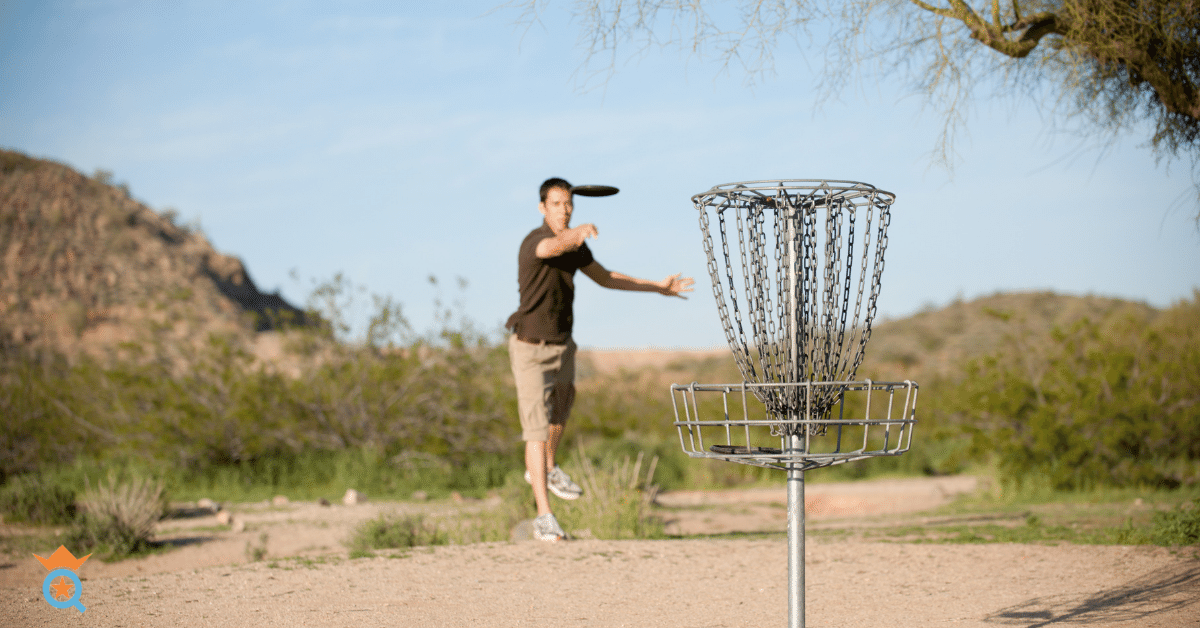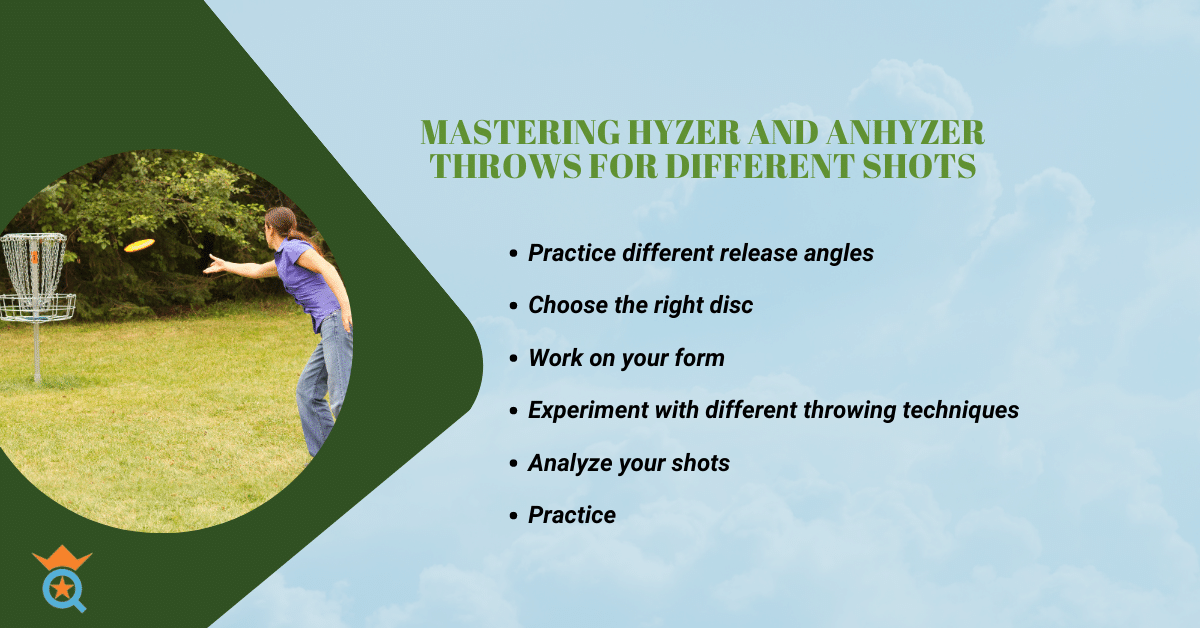In the world of disc golf, mastering different types of throws is crucial to improving your game and navigating various courses. Among the essential techniques to understand are the hyzer and anhyzer throws, which involve specific release angles to achieve desired flight paths.
In this article, we will delve into the importance of hyzer and anhyzer throws, discussing their benefits, differences, and uses for both forehand and backhand throws.
We will also explore the impact of disc stability, including overstable, understable, and stable discs, on these throws and provide tips on how to improve your skills.
By the end of this article, you will have a solid understanding of hyzer and anhyzer throws, allowing you to enhance your disc golf performance and enjoy the game to the fullest.

What is a Hyzer in Disc Golf?
A hyzer is a specific type of throw in disc golf that refers to the angle at which the disc is released. In a hyzer throw, the edge of the disc closest to the thrower is tilted downward, causing the disc to curve away from the thrower's body.
For right-handed players, a hyzer will cause the disc to curve to the left, while for left-handed players, it will curve to the right. This type of throw is an essential skill to master in disc golf, as it allows players to navigate around obstacles and control their shots with precision.
The hyzer angle is the degree to which the disc is tilted downward during the throw. This angle can vary from a slight tilt to a more extreme angle, depending on the desired flight path and the disc's stability.
A more overstable disc will typically require a sharper hyzer angle to achieve the desired curve, while an understable disc may flip up and glide with a more gentle angle.
There are several benefits to using a hyzer shot in disc golf. First and foremost, hyzer throws provide excellent control and predictability, allowing players to place their shots accurately and consistently.
Additionally, hyzer shots are useful for navigating around obstacles or reaching specific landing zones on the course.
Finally, by adjusting the hyzer angle and disc selection, players can achieve a wide range of flight paths and distances, making hyzer throws a versatile and valuable skill in any disc golfer's arsenal.
What is an Anhyzer in Disc Golf?
An anhyzer is another essential type of throw in disc golf, which is essentially the opposite of a hyzer throw. It refers to the angle at which the disc is released with the edge closest to the thrower tilted upward, causing the disc to curve in the opposite direction of the natural fade.
For right-handed players, an anhyzer throw will curve to the right, while for left-handed players, it will curve to the left. Mastering anhyzer throws allows disc golfers to shape their shots in various ways, enabling them to handle a wider range of course layouts and challenges.
The anhyzer angle is the degree to which the disc is tilted upward during the throw. This angle can vary from a slight upward tilt to a more extreme angle, depending on the desired flight path and the disc's stability.
An understable disc will generally produce more turn when thrown with an anhyzer angle, while an overstable disc may require a sharper angle to achieve the desired curve.
There are several benefits to using an anhyzer shot in disc golf. First, anhyzer throws can help players achieve greater distance with an S-shaped flight path that takes full advantage of the disc's flight characteristics. This can be especially helpful when trying to maximize distance on open fairways.
Second, anhyzer shots allow players to shape their throws around obstacles or execute precise shots that require the disc to move from left to right (for right-handed players) or vice versa.
Lastly, an extreme anhyzer angle can be used to produce roller shots, which are useful for navigating tight wooded courses or getting out of difficult situations.
Overall, anhyzer throws are a vital skill for any disc golfer looking to expand their shot repertoire and improve their game.

Hyzer Flip vs Anhyzer: Maximizing Distance
The hyzer flip is a unique throwing technique that combines the release angle of a hyzer throw with the properties of an understable disc. To execute a hyzer flip, a player releases an understable disc with a hyzer angle, and as the disc gains speed, it "flips up" to a flat position or even turns slightly in the opposite direction before fading back.
This particular flight path allows the disc to maximize its glide and take advantage of the full range of its flight characteristics, resulting in greater distance potential.
Some benefits of the hyzer flip for distance include:
- Maximizing glide: The hyzer flip allows the disc to level out or turn slightly, resulting in an increased glide, which contributes to more distance.
- Improved accuracy: As the disc starts on a hyzer angle and transitions to flat or slightly turned, it generally follows a predictable and controllable flight path.
- Versatility: The hyzer flip can be adapted for various discs and power levels, allowing players to fine-tune their throws for specific distances and situations.
- Lower risk of accidental turnovers: Since the throw starts on a hyzer angle, there is less chance of unintentionally turning the disc too much and causing an unwanted flight path.
Comparing Hyzer Flip to Anhyzer Throw for Distance:
Anhyzer throws also have the potential to achieve significant distance, especially when utilizing an S-shaped flight path. However, there are some differences and considerations when comparing them to hyzer flips for distance:
- Predictability: Anhyzer throws can be less predictable than hyzer flips, as the disc's release angle and stability play a significant role in the throw's outcome. An improper angle or disc selection can result in unwanted turnovers or not achieving the desired distance.
- Control: Hyzer flips generally offer better control over the flight path, as they begin with a hyzer angle and transition smoothly through various stages of the throw.
- Disc selection: Anhyzer throws may require a wider range of disc stability options to achieve the desired flight path and distance, while hyzer flips primarily rely on understable discs.
- Technique: Mastering anhyzer throws for distance may take more practice to fine-tune the release angle and disc selection, whereas hyzer flips often provide more immediate and consistent results.
Both hyzer flips and anhyzer throws can be effective for maximizing distance in disc golf. However, hyzer flips often provide better control and predictability, while still offering the potential for significant distance gains.
Players should experiment with both techniques to determine which best suits their skills and preferences.
Disc Golf Stability: Overstable vs Understable vs Stable Discs
Overstable Discs:
- Hyzer Throws: Overstable discs are well-suited for hyzer throws because they maintain their hyzer angle throughout the flight and exhibit a strong fade at the end. This results in a predictable and controlled flight path, which is ideal for navigating around obstacles or landing in specific areas.
- Anhyzer Throws: When thrown with an anhyzer angle, overstable discs will fight against the turn and fade back more aggressively, resulting in a force flex or helix-shaped flight path. This can be useful for controlled S-shape throws in tight or winding fairways.
Understable Discs:
- Hyzer Throws: When thrown with a hyzer angle, understable discs are more likely to flip up to flat or even turn slightly, which is the basis of a hyzer flip throw. This results in greater distance and versatility, as the disc takes advantage of its full flight characteristics.
- Anhyzer Throws: Understable discs are ideal for anhyzer throws, as they will turn more easily during the high-speed portion of their flight, allowing for a more pronounced curve in the desired direction. This can help execute shots that require a left-to-right or right-to-left movement, depending on the player's throwing hand.
Stable Discs:
- Hyzer Throws: Stable discs provide a balanced flight when thrown with a hyzer angle, resisting turning while maintaining a predictable fade. This makes them a versatile choice for a range of hyzer throw situations, offering a balance between control and distance.
- Anhyzer Throws: For anhyzer throws, stable discs offer a smooth and consistent flight path, allowing players to shape their shots with precision. They will not turn as much as understable discs, but they will also not fade back as aggressively as overstable discs, providing a balanced and predictable flight.
In summary, understanding the stability of discs is crucial for executing various hyzer and anhyzer throws in disc golf. Overstable discs are ideal for controlled and predictable hyzer throws, while understable discs are perfect for hyzer flips and pronounced anhyzer turns.
Stable discs provide a balanced flight path for both hyzer and anhyzer throws, making them versatile choices for various situations on the course.

Mastering Hyzer and Anhyzer Throws for Different Shots
To excel in disc golf, players must learn to execute a variety of shots using hyzer and anhyzer throws. These techniques allow disc golfers to navigate around obstacles, control the distance and accuracy of their throws, and shape shots to suit the unique challenges of each hole.
By mastering hyzer and anhyzer shots, players can significantly improve their overall performance on the course.
Tips on how to improve hyzer and anhyzer shots:
- Practice different release angles: Experiment with various angles of release to see how they affect the flight path and distance of your throws. This will help you become more comfortable with different hyzer and anhyzer angles.
- Choose the right disc: Selecting the appropriate disc for each shot, based on stability and speed, is crucial for achieving the desired flight path. Experiment with overstable, understable, and stable discs to understand how they perform with hyzer and anhyzer throws.
- Work on your form: Proper throwing form is essential for achieving consistent results. Focus on the mechanics of your throw, such as footwork, grip, and follow-through, to ensure a smooth and controlled release.
- Experiment with different throwing techniques: Try various hyzer and anhyzer shots, such as the hyzer flip, force flex, and rollers, to expand your skillset and adapt to different situations on the course.
- Analyze your shots: Pay attention to the outcome of your throws and make adjustments to your release angle, disc choice, and technique as needed. Learning from your mistakes and successes will help you improve over time.
- Practice: The more you throw hyzer and anhyzer shots, the more comfortable and proficient you will become. Dedicate time to practice and challenge yourself with different shots to refine your skills.
The importance of release angles and disc choice in executing effective shots cannot be overstated. A proper release angle ensures that the disc follows the desired flight path, while the right disc selection maximizes the potential of each throw.
By paying attention to these two factors and consistently practicing various hyzer and anhyzer shots, disc golfers can elevate their game and tackle even the most challenging courses with confidence.

The Role of Hyzer and Anhyzer Throws in Disc Golf Strategy
In disc golf, understanding and utilizing hyzer and anhyzer throws is crucial for navigating diverse courses and overcoming various obstacles. These throws allow players to control the flight path of their discs, curve around trees or other obstructions, and reach target zones with greater precision.
By incorporating hyzer and anhyzer shots into their strategy, disc golfers can tackle a wide range of challenges and adapt to different course layouts.
Mastering various throws is particularly valuable in competitive disc golf, where players face an array of challenges on the course. By having a diverse skillset that includes hyzer flips, force flexes, rollers, and other specialized throws, disc golfers can stay ahead of the competition and maintain a strategic edge.
Additionally, the ability to execute precise hyzer and anhyzer shots helps players manage risk and make informed decisions when facing difficult holes or complex course conditions.
Conclusion
Understanding the nuances of hyzer and anhyzer throws is essential for disc golfers looking to elevate their game. These techniques provide players with the ability to shape their shots, navigate obstacles, and adapt to different courses, making them invaluable tools for both casual and competitive play.
To truly master these throws, disc golfers should practice consistently, experiment with different discs and release angles, and analyze their shots to refine their technique.
By embracing the challenge and committing to improvement, players can unlock their full potential on the disc golf course and enjoy continued success in this exciting sport.








